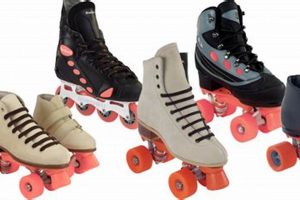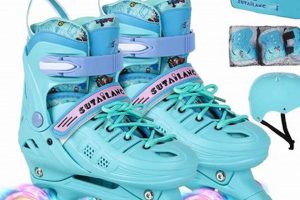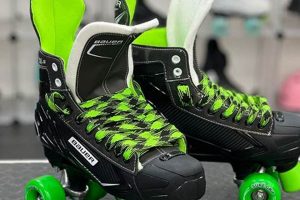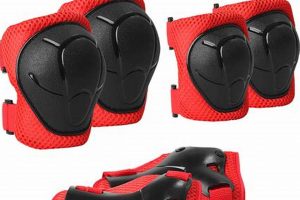Wheeled footwear designed for use on paved outdoor surfaces allows individuals to traverse distances and engage in recreational activities. Such equipment typically incorporates durable wheels, robust bearings, and supportive boot structures to withstand the varied conditions encountered on sidewalks, roads, and other urban environments. As an example, one might use these to commute short distances or perform tricks in designated skating areas.
The adaptation of skating technology for external environments offers a blend of exercise, transportation, and leisure. Historically, the evolution of these designs reflects an ongoing effort to improve stability, speed, and maneuverability on asphalt and concrete. Benefits include enhanced cardiovascular health, improved coordination, and an alternative mode of short-distance travel. This form of recreation also fosters community and encourages outdoor activity.
The following sections will delve into specific aspects related to outdoor skating equipment, including ideal wheel materials, bearing considerations, frame construction, and protective gear recommendations. Furthermore, an examination of maintenance practices and relevant safety guidelines will be provided.
Guidelines for Outdoor Skating
Optimizing the outdoor skating experience necessitates careful attention to equipment selection, maintenance, and safety precautions. The following recommendations provide a framework for maximizing performance and minimizing risks associated with traversing paved surfaces on wheeled footwear.
Tip 1: Wheel Durometer Selection: Select wheels with a durometer rating appropriate for the skating surface. Softer wheels (e.g., 78A-82A) offer enhanced grip and shock absorption on rougher surfaces, while harder wheels (e.g., 84A+) provide increased speed and durability on smoother terrains. Observe wheel wear and replace when necessary.
Tip 2: Bearing Maintenance: Regularly clean and lubricate bearings to maintain optimal rolling efficiency. Debris accumulation reduces bearing performance and increases the effort required for propulsion. A suitable bearing cleaning kit and lubricant are recommended.
Tip 3: Frame Integrity Inspection: Periodically inspect the skate frame for cracks, bends, or loose hardware. Frame failure compromises stability and increases the risk of injury. Damaged frames should be repaired or replaced by a qualified technician.
Tip 4: Protective Gear Utilization: Always wear appropriate protective gear, including a helmet, wrist guards, elbow pads, and knee pads. These items mitigate the severity of injuries sustained during falls or collisions. Ensure proper fit and secure fastening of all protective equipment.
Tip 5: Surface Assessment: Prior to skating, assess the skating surface for hazards such as potholes, cracks, gravel, and vehicular traffic. Avoid skating in areas with significant surface irregularities or high traffic volume. Choose well-maintained and designated skating paths when available.
Tip 6: Braking Proficiency: Develop proficiency in various braking techniques, including heel brakes (if equipped) and T-stops. The ability to effectively control speed and stop quickly is essential for avoiding collisions and maintaining safety.
Tip 7: Visibility Enhancement: When skating in low-light conditions, wear brightly colored clothing or reflective gear to enhance visibility to other road users. Consider using LED lights attached to the skates or clothing for added safety.
Adhering to these guidelines enhances both safety and performance, thereby maximizing enjoyment of the outdoor skating activity. Consistent application of these recommendations contributes to a more secure and fulfilling skating experience.
The subsequent sections will address more specialized topics related to advanced skating techniques and equipment modifications.
1. Wheel Durometer
Wheel durometer, measured on the Shore A scale, represents a crucial property of skate wheels, dictating their hardness and, consequently, their performance characteristics on various street surfaces. For wheeled boots intended for use on paved outdoor environments, the selection of an appropriate durometer rating directly influences grip, rolling resistance, and durability. A lower durometer (e.g., 78A-82A) indicates a softer wheel, providing superior grip on rough asphalt or concrete, absorbing vibrations, and enhancing control. A higher durometer (e.g., 84A+) signifies a harder wheel, offering reduced rolling resistance and increased speed on smoother surfaces, but at the expense of grip and shock absorption. The interplay between wheel durometer and street surface characteristics directly impacts the skater’s ability to maintain balance, control speed, and execute maneuvers safely and efficiently. For example, using high durometer wheels on a cracked and uneven sidewalk will result in a jarring ride, reduced control, and potentially increased risk of falls. Conversely, low durometer wheels on a perfectly smooth surface might feel sluggish and lack the desired speed for recreational skating.
The practical significance of understanding wheel durometer extends to both beginner and experienced skaters. A novice learning to skate benefits from softer wheels, as the increased grip provides greater stability and confidence while mastering basic skills. More experienced skaters, seeking to optimize performance for specific activities, can strategically choose wheel durometers based on the anticipated terrain. For instance, skaters engaging in urban exploration or aggressive skating often prefer slightly harder wheels to enhance speed and slide control, while still maintaining sufficient grip for varying street conditions. Furthermore, wheel durometer affects wheel wear; softer wheels tend to wear down more quickly on abrasive surfaces compared to harder wheels, requiring more frequent replacement.
In summary, wheel durometer is a critical factor in determining the suitability of wheeled boots for use on streets. The appropriate durometer rating depends on a complex interaction between surface conditions, skating style, and individual skill level. Careful consideration of these factors enables skaters to optimize their equipment for performance, comfort, and safety. A mismatch between wheel durometer and the skating environment can lead to compromised control, increased fatigue, and elevated risk of injury, highlighting the importance of informed wheel selection. The challenges lie in finding the optimal balance between grip, speed, and durability to suit the diverse and often unpredictable nature of street skating environments.
2. Bearing Precision
Bearing precision in wheeled boots significantly impacts performance and efficiency, particularly when navigating the variable conditions encountered on paved surfaces. High-precision bearings minimize friction, leading to increased speed, reduced energy expenditure, and enhanced control. This feature is especially crucial when dealing with uneven terrain and longer distances typically associated with outdoor skating.
- ABEC Rating and its Significance
The Annular Bearing Engineers’ Committee (ABEC) rating system (ranging from ABEC 1 to ABEC 9) defines the tolerances and precision of bearings. Higher ABEC ratings indicate tighter tolerances, resulting in smoother and faster rolling. While high ABEC ratings may seem desirable, they are not always necessary for street skating. Bearings with moderate ABEC ratings (e.g., ABEC 5 or ABEC 7) often provide a good balance between performance, durability, and cost-effectiveness for the street environment, where impacts and debris can degrade bearing performance.
- Bearing Material and Construction
Bearing materials, such as stainless steel or ceramic, influence durability and resistance to corrosion. Stainless steel bearings offer good all-around performance for street skating, providing adequate rust resistance and strength. Ceramic bearings, although more expensive, offer superior hardness, lower friction, and greater resistance to heat buildup, potentially extending bearing life in demanding conditions. Bearing construction also plays a role, with sealed bearings providing protection against dirt and moisture ingress, which is critical for maintaining performance on outdoor surfaces.
- Lubrication and Maintenance
Proper lubrication is essential for maintaining bearing precision and prolonging bearing lifespan. Bearing lubricants reduce friction, dissipate heat, and protect bearing components from corrosion. Regular cleaning and lubrication are necessary, especially after exposure to wet or dirty conditions. The type of lubricant used can also affect bearing performance, with lighter oils generally preferred for speed and heavier greases providing enhanced protection in harsh environments. Ignoring lubrication can lead to increased friction, reduced speed, and premature bearing failure.
- Impact of Debris and Contaminants
Street environments expose bearings to various debris and contaminants, including dirt, sand, and water. These contaminants can infiltrate bearings, increasing friction, accelerating wear, and reducing overall precision. Sealed bearings offer a degree of protection, but regular cleaning and maintenance are still necessary to remove accumulated debris. Skating in wet conditions should be avoided whenever possible, and bearings should be thoroughly dried and re-lubricated after exposure to moisture. Selecting bearings designed for outdoor use, with enhanced sealing and rust resistance, can help mitigate the impact of environmental factors.
The interplay between ABEC rating, material composition, lubrication practices, and environmental factors directly affects the rolling efficiency of wheeled boots on streets. While high ABEC ratings may offer marginal performance gains, diligent maintenance and the selection of robust, sealed bearings are often more critical for ensuring longevity and consistent performance in the challenging conditions inherent to street skating.
3. Frame Material
The material composition of a wheeled boot’s frame fundamentally influences its durability, weight, responsiveness, and overall suitability for street skating. The frame serves as the critical link between the boot, wheels, and bearings, directly impacting the skater’s control, stability, and energy transfer.
- Aluminum Alloys
Aluminum alloys represent a prevalent choice for street skate frames due to their favorable strength-to-weight ratio. Frames crafted from aluminum exhibit high stiffness, enhancing energy transfer during strides and providing precise control. Different aluminum alloys, such as 6061 or 7005, offer varying degrees of strength and corrosion resistance, influencing the frame’s longevity and performance under stress. Extruded aluminum frames provide a balance of strength and affordability, while CNC-machined frames offer increased precision and design flexibility. A skater performing jumps and grinds benefits significantly from the durability of an aluminum frame, minimizing the risk of bending or breakage.
- Composite Materials
Composite materials, such as carbon fiber or fiberglass reinforced polymers, offer lightweight alternatives to aluminum. Composite frames excel in absorbing vibrations and dampening road noise, enhancing comfort during extended skating sessions. While generally lighter than aluminum frames, composite frames may exhibit lower impact resistance and can be more prone to damage from abrasion or sharp impacts. The use of composite materials in street skate frames often targets recreational skaters prioritizing comfort and weight reduction over extreme durability. Hybrid frames combining composite materials with aluminum reinforcements represent a compromise, offering a balance of weight savings and structural integrity.
- Steel
Steel frames, while less common in contemporary street skate designs, offer exceptional durability and resistance to bending. Steel frames are typically heavier than aluminum or composite frames, which can impact maneuverability and increase fatigue. However, the high strength of steel makes it suitable for aggressive skating styles involving jumps, grinds, and impacts. Steel frames are often found in older skate models or custom-built setups prioritizing robustness and longevity. The added weight of steel can provide increased stability, particularly for larger skaters or those skating at high speeds.
- Frame Length and Mounting Systems
The length of the frame, typically measured in millimeters, affects stability and maneuverability. Shorter frames offer increased agility and responsiveness, facilitating quick turns and tricks. Longer frames provide greater stability at high speeds, making them suitable for distance skating or downhill runs. The mounting system, which connects the frame to the boot, also plays a crucial role. Standard mounting systems allow for frame replacement or adjustment, while integrated mounting systems provide a more direct connection, enhancing energy transfer. The choice of frame length and mounting system should align with the skater’s skill level, skating style, and desired performance characteristics.
The selection of frame material for wheeled boots directly influences the skating experience on streets. Aluminum alloys provide a balance of strength, weight, and responsiveness suitable for a wide range of skating styles. Composite materials prioritize comfort and weight reduction, while steel offers unmatched durability. The optimal choice depends on the skater’s individual needs, preferences, and the specific demands of their intended use. Careful consideration of frame material properties, in conjunction with frame length and mounting system compatibility, is essential for maximizing performance, comfort, and safety while navigating the varied conditions of street skating environments.
4. Boot Support
Adequate boot support is paramount for safe and efficient utilization of wheeled boots on streets. The boot structure provides the essential interface between the skater’s foot and the frame, impacting stability, control, and injury prevention. Insufficient support can lead to ankle strain, reduced power transfer, and an increased risk of falls, particularly on uneven or unpredictable surfaces.
- Ankle Stability and Injury Prevention
Robust ankle support is crucial for maintaining balance and preventing injuries. The boot should provide firm lateral and medial support to limit ankle pronation and supination, reducing the risk of sprains and strains. High-cut boots or those with reinforced ankle cuffs offer enhanced stability, especially beneficial for beginners or skaters navigating rough terrain. Properly fitted boots, secured with laces, buckles, or power straps, ensure the foot remains firmly in place, minimizing unwanted movement and maximizing control. Examples include supportive cuffs that restrict excessive ankle movement or heat-moldable liners that conform to the foot for a secure fit. The implications of inadequate ankle support can range from minor discomfort to severe ligament damage, underscoring the importance of prioritizing stability in boot selection.
- Power Transfer and Efficiency
Effective boot support optimizes power transfer from the skater’s leg muscles to the wheels. A stiff and responsive boot prevents energy loss due to flex or deformation, allowing for more efficient strides and increased speed. Carbon fiber or composite shells provide maximum stiffness, while padded liners enhance comfort and cushioning. Secure fastening systems, such as ratcheting buckles or lace closures, ensure a snug fit, further minimizing energy dissipation. Consider a skater pushing off for a stride; if the boot flexes excessively, a portion of the energy is lost in the boot’s deformation rather than being transferred to the wheels. Consequently, a supportive boot directly translates into increased skating efficiency and reduced fatigue, particularly over long distances or during intense activity.
- Comfort and Fit
While prioritizing support, boot comfort remains a vital consideration. A well-fitting boot minimizes friction and pressure points, preventing blisters and discomfort. Heat-moldable liners allow for customization, conforming to the unique contours of the skater’s foot. Adequate ventilation promotes airflow, reducing moisture buildup and preventing overheating. Padded tongues and ankle collars enhance comfort and prevent chafing. Examples include boots with adjustable straps that allow skaters to fine-tune the fit for optimal comfort or breathable mesh panels that improve ventilation. A comfortable boot encourages longer skating sessions and reduces the likelihood of developing foot problems, contributing to a more enjoyable and sustainable skating experience.
- Durability and Longevity
Durable boot materials and construction contribute to the longevity and performance of wheeled boots. Reinforced stitching, abrasion-resistant outer shells, and robust fastening systems withstand the rigors of street skating. High-quality boots maintain their shape and support over time, preventing premature wear and tear. Protective toe caps and heel counters guard against impacts and abrasion. The use of durable materials, such as ballistic nylon or reinforced leather, ensures the boot can withstand the demands of regular use on varied surfaces. Investing in a well-constructed boot translates into long-term cost savings and consistent performance, providing a reliable and supportive platform for street skating activities.
The multifaceted nature of boot support highlights its integral role in the performance and safety of wheeled boots utilized on streets. By addressing ankle stability, power transfer, comfort, and durability, manufacturers strive to create boots that meet the diverse needs of street skaters. The optimal boot choice hinges on a careful balance of these factors, aligning with individual skating style, skill level, and anticipated usage conditions. This is not merely about selecting footwear but about integrating the human element with the machinery of skating to provide a seamless and supportive ride.
5. Braking System
The braking system represents a critical safety component in wheeled boots designed for use on streets. Its effectiveness directly influences the skater’s ability to control speed, avoid obstacles, and mitigate the risk of collisions in dynamic outdoor environments.
- Heel Brakes: Design and Functionality
Heel brakes, commonly found on recreational skates, consist of a brake pad mounted on the heel of one or both boots. Activating the brake involves lifting the toe of the skating foot, forcing the brake pad into contact with the ground. Heel brakes offer intuitive operation for novice skaters but can be less effective at higher speeds or on steep inclines. Some designs allow for height adjustment or replacement of the brake pad as it wears. The brake pad material affects stopping power and durability; harder compounds provide longer life but may reduce grip, while softer compounds offer superior stopping power but wear down more quickly. For instance, a skater navigating a crowded sidewalk can use heel brakes for controlled speed reduction and collision avoidance.
- Inline Brakes: T-Stop and Parallel Slide
Advanced braking techniques, such as the T-stop and parallel slide, require greater skill and practice. The T-stop involves positioning one skate perpendicular to the direction of travel, using friction to slow down. The parallel slide involves a controlled sideways slide, dissipating energy through friction. These techniques provide greater stopping power and control compared to heel brakes but demand precise body positioning and weight distribution. For example, a skater descending a moderate hill may employ a T-stop to maintain a safe speed, while a more experienced skater might execute a parallel slide for rapid deceleration. Mastery of these techniques expands braking options and enhances safety in various skating scenarios.
- Brake Maintenance and Inspection
Regular inspection and maintenance of braking components are essential for optimal performance. Brake pads should be checked for wear and replaced when the thickness falls below a safe threshold. Fastening hardware, such as bolts and screws, should be tightened to prevent loosening. Heel brake mechanisms should be lubricated to ensure smooth operation. Neglecting maintenance can compromise braking effectiveness, increasing the risk of accidents. A skater who regularly inspects their heel brake will ensure consistent stopping power.
- Emergency Stopping Techniques
In emergency situations, skaters may need to resort to unconventional stopping methods. Dragging a hand or foot along the ground can provide a last-resort braking force, although it carries a risk of injury. Deliberately falling in a controlled manner can also be used to stop quickly, albeit with potential consequences. The effectiveness of emergency techniques depends on the skater’s skill, the skating surface, and the surrounding environment. While not ideal, knowing these techniques can provide a measure of control in unexpected situations.
The integration of a functional and well-maintained braking system is paramount for safe and responsible wheeled boot use on streets. Whether utilizing heel brakes or mastering advanced techniques, skaters must prioritize braking proficiency to navigate the unpredictable conditions of urban environments. The ability to effectively control speed and stop quickly directly contributes to the safety of both the skater and those sharing the public space, emphasizing the significance of braking as a fundamental aspect of street skating.
6. Surface Condition
The suitability of wheeled boots for use on streets is fundamentally contingent upon the prevailing surface conditions. The state of the pavement, including its smoothness, presence of irregularities, and degree of contamination, directly dictates the rolling efficiency, stability, and safety of the skater. A smooth, clean surface facilitates optimal rolling, allowing for efficient energy transfer and minimal vibration. Conversely, a surface riddled with cracks, potholes, or debris impedes smooth movement, increases the risk of falls, and necessitates greater effort to maintain balance and control. The causal relationship between surface condition and skating performance is readily observable in everyday urban environments.
The practical significance of understanding this connection lies in the ability to make informed decisions regarding equipment selection and route planning. A skater anticipating traversal of rough surfaces would benefit from selecting wheels with a lower durometer rating, providing enhanced grip and shock absorption. Furthermore, awareness of surface conditions allows for proactive avoidance of hazardous areas, minimizing the potential for accidents. For instance, a skater encountering a section of road construction may choose to dismount and walk, rather than attempt to navigate the uneven terrain and potential obstacles. Cities with well-maintained pedestrian walkways and designated skating areas demonstrably encourage safer and more accessible wheeled boot use, highlighting the importance of infrastructure investment in promoting this activity.
In conclusion, surface condition constitutes a critical, and often overlooked, component of the street skating experience. Its influence extends beyond mere convenience, impacting safety, efficiency, and overall enjoyment. Addressing the challenges posed by variable surface conditions requires a multifaceted approach, encompassing careful equipment selection, informed route planning, and proactive maintenance of skating surfaces. A comprehensive appreciation of the interplay between surface condition and skating performance is essential for fostering a safe and sustainable environment for wheeled boot use in urban settings, and more attention is therefore a critical element for future exploration, development, and adoption of these sporting products.
7. Protective Gear
The use of wheeled boots on streets introduces an inherent risk of falls and collisions. Protective gear serves as a critical safeguard, mitigating the potential severity of injuries sustained during such incidents. Consistent utilization of appropriate protective equipment is paramount for ensuring skater safety and promoting responsible engagement in this activity.
- Helmets: Head Injury Prevention
Helmets constitute the most essential piece of protective gear for street skating, safeguarding the head against traumatic brain injuries. Helmets absorb impact energy, reducing the force transmitted to the skull and brain. Models certified to recognized safety standards, such as ASTM or CPSC, provide a reliable level of protection. A properly fitted helmet should sit snugly on the head, covering the forehead and temples, and should be replaced after any significant impact. For example, a skater wearing a helmet who falls and strikes their head on the pavement is significantly less likely to suffer a serious head injury compared to one without a helmet.
- Wrist Guards: Fracture Mitigation
Wrist guards protect the wrists from fractures and sprains, common injuries resulting from falls. Wrist guards typically consist of a rigid plastic splint and padding that absorb impact energy and distribute force away from the wrist joint. Well-designed wrist guards allow for a full range of motion while providing adequate protection. They are particularly beneficial for novice skaters who instinctively reach out to break their falls. An example is a skater wearing wrist guards who falls forward; the guards will absorb much of the impact force that would otherwise be concentrated on the wrist, preventing or reducing the severity of a fracture.
- Elbow and Knee Pads: Abrasion and Impact Resistance
Elbow and knee pads provide protection against abrasions, contusions, and joint injuries. These pads typically consist of a hard outer shell and a soft inner lining that cushion the impact. Knee pads are especially important for protecting the knees during falls on rough surfaces. Elbow pads offer similar protection for the elbows. The effectiveness of these pads depends on their fit, coverage area, and impact absorption capabilities. For instance, a skater wearing knee pads who slides across asphalt will avoid severe abrasions and potential knee joint damage.
- Mouthguards: Dental Protection
While less commonly used in recreational skating, mouthguards offer valuable protection for the teeth and jaw. Mouthguards absorb impact energy, preventing dental fractures, dislocations, and concussions. They are particularly recommended for aggressive skating styles involving jumps and tricks. Custom-fitted mouthguards offer the best protection and comfort, but over-the-counter options are also available. As an example, a skater performing a trick who loses balance and impacts their face on the ground can prevent significant dental damage by wearing a mouthguard.
The multifaceted benefits of protective gear underscore its indispensable role in mitigating the risks associated with street skating. By addressing head injuries, wrist fractures, abrasions, and dental trauma, protective equipment provides a comprehensive safety net. The consistent and proper utilization of helmets, wrist guards, elbow pads, knee pads, and mouthguards significantly reduces the likelihood and severity of injuries, promoting a safer and more sustainable environment for engagement with wheeled boots on streets. Its promotion should therefore be a key part of any education effort targeted at new and current users.
Frequently Asked Questions
This section addresses common inquiries concerning the selection, usage, and maintenance of wheeled boots designed for use on paved surfaces. The information presented aims to provide clarity and guidance to individuals seeking to engage in this activity safely and effectively.
Question 1: What constitutes a suitable wheel durometer for navigating rough asphalt?
A lower durometer rating (e.g., 78A-82A) is generally recommended for rough asphalt surfaces. These softer wheels offer enhanced grip and shock absorption, improving stability and control.
Question 2: How frequently should bearings be cleaned and lubricated for optimal performance?
Bearing cleaning and lubrication frequency depends on usage conditions. Under typical circumstances, cleaning and lubrication every 20-40 hours of use is advisable. More frequent maintenance is necessary following exposure to wet or dirty environments.
Question 3: What are the key indicators that a skate frame requires repair or replacement?
Cracks, bends, or loose hardware indicate potential frame failure. Any compromise to the frame’s structural integrity necessitates immediate repair or replacement to prevent accidents.
Question 4: Which protective gear elements are considered indispensable for safe street skating?
A helmet is non-negotiable. Wrist guards, elbow pads, and knee pads provide essential protection against common injuries sustained during falls. Mouthguards offer additional protection.
Question 5: How does one effectively assess the safety of a skating surface prior to engaging in the activity?
Carefully inspect the surface for hazards such as potholes, cracks, gravel, and vehicular traffic. Avoid areas with significant surface irregularities or high traffic volume. Choose well-maintained and designated skating paths when available.
Question 6: What braking techniques are recommended for controlling speed on moderate inclines?
Advanced braking techniques, such as the T-stop or parallel slide, provide greater control compared to heel brakes. Proficiency in these techniques requires practice and proper body positioning.
The information provided here underscores the importance of informed decision-making regarding equipment selection, maintenance practices, and safety precautions. Prioritizing safety and diligence enhances both the performance and enjoyment of this activity.
The subsequent sections will delve into more specialized topics regarding wheeled boots for urban environments, including specific product recommendations and advanced skating techniques.
Roller Skates for the Street
The preceding analysis has explored the multifaceted aspects of roller skates for the street, encompassing equipment selection, maintenance protocols, safety measures, and considerations related to various skating environments. Crucial determinants of performance and safety include wheel durometer, bearing precision, frame material, boot support, and braking system efficacy. Protective gear, such as helmets and pads, remains indispensable for injury mitigation. Surface conditions exert a significant influence on the skating experience, necessitating careful assessment prior to engagement. Addressing these factors comprehensively provides a foundation for informed decision-making.
The responsible use of roller skates for the street demands adherence to established safety guidelines and a commitment to proactive maintenance practices. The long-term sustainability of this recreational activity hinges on the adoption of responsible skating behaviors and the promotion of a safety-conscious culture among participants. Further research and development in materials science, biomechanics, and safety technology may contribute to enhanced equipment performance and reduced injury rates. The integration of smart technologies, such as sensors and feedback systems, could potentially provide real-time monitoring of skating conditions and enhance skater awareness. A continued focus on safety and technological advancement is essential for ensuring the enduring viability of street skating.







